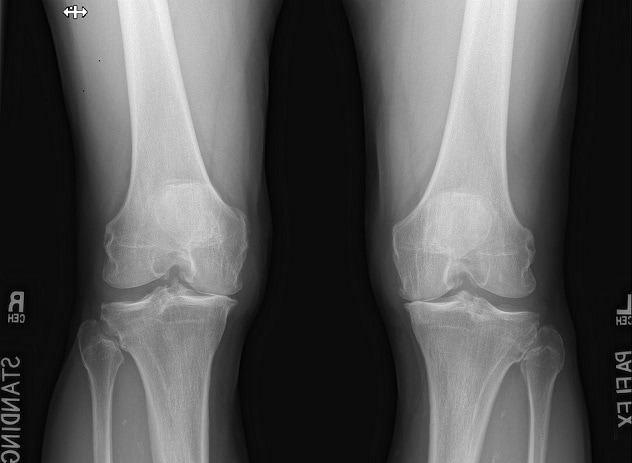Aug. 26, 2023
Most partial knee replacement surgery is not intended to prepare patients to run marathons. Rather, the objective is to equip them for a more active lifestyle, including low-impact sports, if desired, and restore ability to perform everyday activities.
Yet a patient of Cedric J. Ortiguera, M.D., an orthopedic surgeon, a sports medicine specialist and vice chair of Orthopedic Surgery at Mayo Clinic in Florida, had such a positive outcome following partial knee replacement that she ran the New York City Marathon.
This type of knee replacement is less common than a total knee replacement: Only 10% to 15% of patients who see an orthopedic surgeon for potential knee replacement are candidates.
How damage develops and leads to a need for partial knee replacement
The most common reason for a partial knee replacement is osteoarthritis, which affects many patients who desire to remain active as they age. History of knee injury as a youth or young adult also may precipitate need for a partial knee replacement later. Such history increases arthritis development risk at a younger age than for individuals who have not experienced knee injury.
Notably, other types of inflammatory arthritis, such as rheumatoid arthritis, are relative exclusion criteria for partial knee replacement. Individuals diagnosed with inflammatory arthritis typically have diffuse knee damage, while damage confined to one of the knee's three compartments is most appropriate for partial knee replacement.
Eligibility criteria

Preoperative image of the knees of a patient who had a partial knee replacement
Before considering a partial knee replacement, Mayo Clinic orthopedic surgeons recommend nonoperative therapies such as weight loss, physical therapy or injections. Some patients with more-isolated cartilage damage may be candidates for other cartilage restoration procedures.
If patients' injuries prove refractive to these therapies, however, the following partial knee replacement criteria have been used:
- Arthritis isolated to one compartment of the knee.
- Pain present in a limited region.
- Not obese.
- Not significantly knock-kneed or bowlegged.
- Preserved range of motion.
- Failure of less invasive treatments.
One of the major benefits of partial knee replacement is preservation of the ACL and PCL.
Orthopedic surgeons often perform partial knee replacement in younger patients — those under age 50 — rather than total knee replacement. Yet Dr. Ortiguera stresses there is no precise age cutoff for this surgery, as it is based on a patient's overall health and severity of arthritis.
Partial knee replacement benefits
For patients who meet eligibility criteria for partial knee replacement, Dr. Ortiguera sees several key advantages compared with total knee replacement, such as:
- Less invasive surgery.
- Shorter procedure, thus decreased time under anesthesia.
- Reduced pain due to a minimized surgery.
- Decreased blood loss.
- Faster recovery — about half of total knee replacement recovery time — due to the reduced complexity of this surgery and postsurgical pain.
- Quicker return to work. Patients who work in desk jobs can return to work in two weeks.
- More rapid return to daily exercise, such as tennis or golf.
Dr. Ortiguera indicates that individuals who work on their feet all day may require 6 to 8 weeks away from work. This allows time for full rehabilitation from the procedure.
Partial knee replacement satisfaction

Postoperative image of the knees of a patient who had a partial knee replacement
Overall, Dr. Ortiguera finds that patients are more satisfied with results from partial knee replacement when compared with patients with total knee replacement.
"Patients look for a partial knee replacement option due to the quicker recovery and how the knee feels postsurgically," he says. "Many patients tell me that their knees still feel natural with this type of knee replacement," he says.
While a large majority of patients who undergo total knee replacement are satisfied with the procedure, satisfaction is not as high as with partial knee replacement: Up to 20% of patients with total knee replacement are unsatisfied. Generally, these patients describe their dissatisfaction as a knee that feels stiff, tight or more unnatural than a native knee.
Referrals for partial knee replacement
For partial knee replacement, Dr. Ortiguera suggests referring patients to a medical center such as Mayo Clinic that performs a high volume of this type of replacement for the best expertise, experience and outcome.
"This is a surgery that is difficult to do properly if you don't do a lot of them," he says. "It's more challenging than a full replacement."
Both high volume and investments in robotics have made a difference at Mayo Clinic and allow its orthopedic surgeons to perform partial knee replacements at an optimal level for patients interested in this option, according to Dr. Ortiguera.
If a patient needs another knee issue addressed, such as a cartilage replacement, Mayo Clinic also is equipped to treat any knee joint dysfunction presented. If coordination of care is needed, orthopedic surgeons can refer the patient internally to an appropriate specialist.
For more information
Refer a patient to Mayo Clinic.